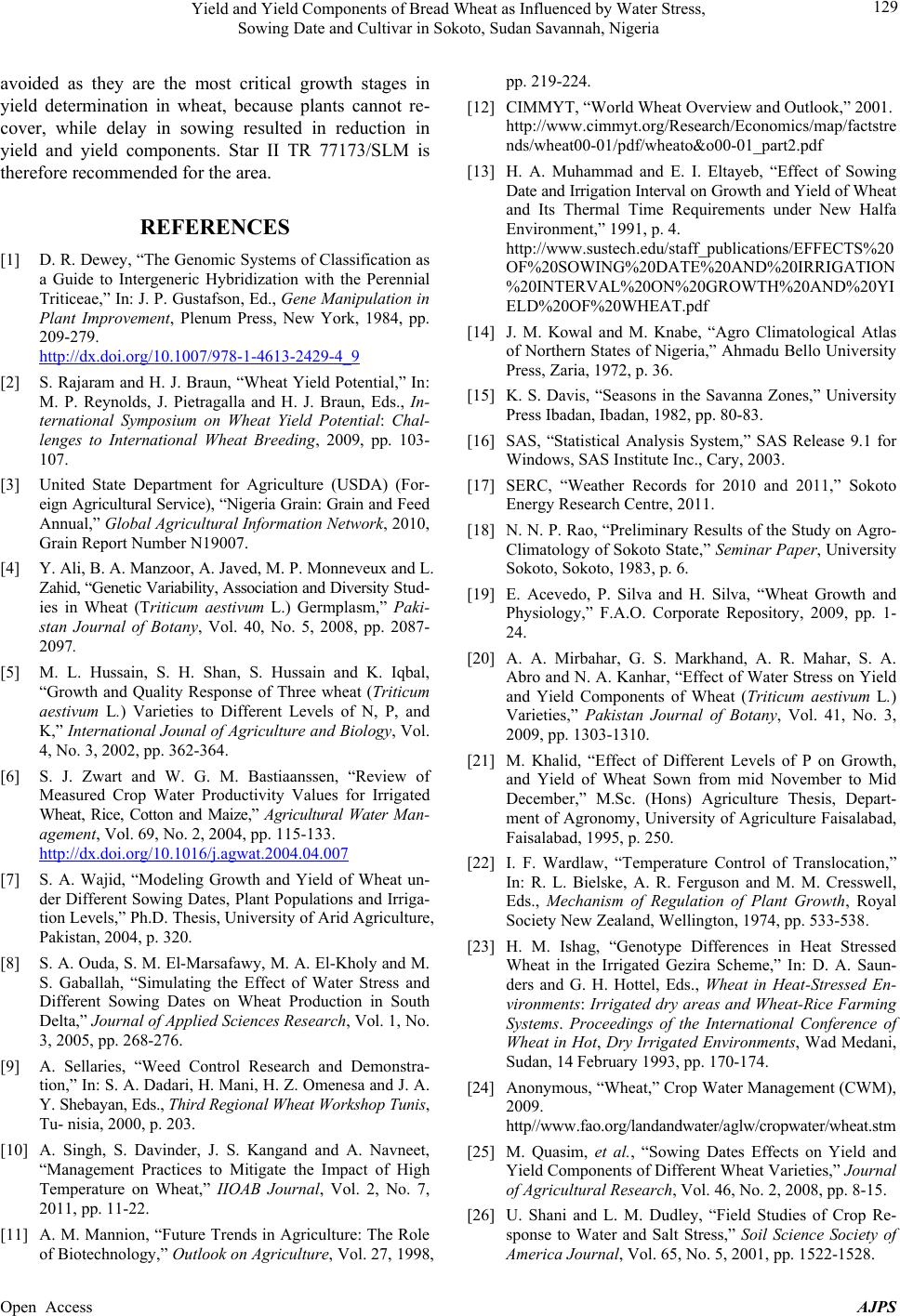
Yield and Yield Components of Bread Wheat as Influenced by Water Stress,
Sowing Date and Cultivar in Sokoto, Sudan Savannah, Nigeria
129
avoided as they are the most critical growth stages in
yield determination in wheat, because plants cannot re-
cover, while delay in sowing resulted in reduction in
yield and yield components. Star II TR 77173/SLM is
therefore recommended for the area.
REFERENCES
[1] D. R. Dewey, “The Genomic Systems of Classification as
a Guide to Intergeneric Hybridization with the Perennial
Triticeae,” In: J. P. Gustafson, Ed., Gene Manipulation in
Plant Improvement, Plenum Press, New York, 1984, pp.
209-279.
http://dx.doi.org/10.1007/978-1-4613-2429-4_9
[2] S. Rajaram and H. J. Braun, “Wheat Yield Potential,” In:
M. P. Reynolds, J. Pietragalla and H. J. Braun, Eds., In-
ternational Symposium on Wheat Yield Potential: Chal-
lenges to International Wheat Breeding, 2009, pp. 103-
107.
[3] United State Department for Agriculture (USDA) (For-
eign Agricultural Service), “Nigeria Grain: Grain and Feed
Annual,” Global Agricultural Information Network, 2010,
Grain Report Number N19007.
[4] Y. Ali, B. A. Manzoor, A. Javed, M. P. Monneveux and L.
Zahid, “Genetic Variability, Association and Diversity Stud-
ies in Wheat (Triticum aestivum L.) Germplasm,” Paki-
stan Journal of Botany, Vol. 40, No. 5, 2008, pp. 2087-
2097.
[5] M. L. Hussain, S. H. Shan, S. Hussain and K. Iqbal,
“Growth and Quality Response of Three wheat (Triticum
aestivum L.) Varieties to Different Levels of N, P, and
K,” International Jounal of Agriculture and Biology, Vol.
4, No. 3, 2002, pp. 362-364.
[6] S. J. Zwart and W. G. M. Bastiaanssen, “Review of
Measured Crop Water Productivity Values for Irrigated
Wheat, Rice, Cotton and Maize,” Agricultural Water Man-
agement, Vol. 69, No. 2, 2004, pp. 115-133.
http://dx.doi.org/10.1016/j.agwat.2004.04.007
[7] S. A. Wajid, “Modeling Growth and Yield of Wheat un-
der Different Sowing Dates, Plant Populations and Irriga-
tion Levels,” Ph.D. Thesis, University of Arid Agriculture,
Pakistan, 2004, p. 320.
[8] S. A. Ouda, S. M. El-Marsafawy, M. A. El-Kholy and M.
S. Gaballah, “Simulating the Effect of Water Stress and
Different Sowing Dates on Wheat Production in South
Delta,” Journal of Applied Sciences Research, Vol. 1, No.
3, 2005, pp. 268-276.
[9] A. Sellaries, “Weed Control Research and Demonstra-
tion,” In: S. A. Dadari, H. Mani, H. Z. Omenesa and J. A.
Y. Shebayan, Eds., Third Regional Wheat Workshop Tunis,
Tu- nisia, 2000, p. 203.
[10] A. Singh, S. Davinder, J. S. Kangand and A. Navneet,
“Management Practices to Mitigate the Impact of High
Temperature on Wheat,” IIOAB Journal, Vol. 2, No. 7,
2011, pp. 11-22.
[11] A. M. Mannion, “Future Trends in Agriculture: The Role
of Biotechnology,” Outlook on Agriculture, Vol. 27, 1998,
pp. 219-224.
[12] CIMMYT, “World Wheat Overview and Outlook,” 2001.
http://www.cimmyt.org/Research/Economics/map/factstre
nds/wheat00-01/pdf/wheato&o00-01_part2.pdf
[13] H. A. Muhammad and E. I. Eltayeb, “Effect of Sowing
Date and Irrigation Interval on Growth and Yield of Wheat
and Its Thermal Time Requirements under New Halfa
Environment,” 1991, p. 4.
http://www.sustech.edu/staff_publications/EFFECTS%20
OF%20SOWING%20DATE%20AND%20IRRIGATION
%20INTERVAL%20ON%20GROWTH%20AND%20YI
ELD%20OF%20WHEAT.pdf
[14] J. M. Kowal and M. Knabe, “Agro Climatological Atlas
of Northern States of Nigeria,” Ahmadu Bello University
Press, Zaria, 1972, p. 36.
[15] K. S. Davis, “Seasons in the Savanna Zones,” University
Press Ibadan, Ibadan, 1982, pp. 80-83.
[16] SAS, “Statistical Analysis System,” SAS Release 9.1 for
Windows, SAS Institute Inc., Cary, 2003.
[17] SERC, “Weather Records for 2010 and 2011,” Sokoto
Energy Research Centre, 2011.
[18] N. N. P. Rao, “Preliminary Results of the Study on Agro-
Climatology of Sokoto State,” Seminar Paper, University
Sokoto, Sokoto, 1983, p. 6.
[19] E. Acevedo, P. Silva and H. Silva, “Wheat Growth and
Physiology,” F.A.O. Corporate Repository, 2009, pp. 1-
24.
[20] A. A. Mirbahar, G. S. Markhand, A. R. Mahar, S. A.
Abro and N. A. Kanhar, “Effect of Water Stress on Yield
and Yield Components of Wheat (Triticum aestivum L.)
Varieties,” Pakistan Journal of Botany, Vol. 41, No. 3,
2009, pp. 1303-1310.
[21] M. Khalid, “Effect of Different Levels of P on Growth,
and Yield of Wheat Sown from mid November to Mid
December,” M.Sc. (Hons) Agriculture Thesis, Depart-
ment of Agronomy, University of Agriculture Faisalabad,
Faisalabad, 1995, p. 250.
[22] I. F. Wardlaw, “Temperature Control of Translocation,”
In: R. L. Bielske, A. R. Ferguson and M. M. Cresswell,
Eds., Mechanism of Regulation of Plant Growth, Royal
Society New Zealand, Wellington, 1974, pp. 533-538.
[23] H. M. Ishag, “Genotype Differences in Heat Stressed
Wheat in the Irrigated Gezira Scheme,” In: D. A. Saun-
ders and G. H. Hottel, Eds., Wheat in Heat-Stressed En-
vironments: Irrigated dry areas and Wheat-Rice Farming
Systems. Proceedings of the International Conference of
Wheat in Hot, Dry Irrigated Environments, Wad Medani,
Sudan, 14 February 1993, pp. 170-174.
[24] Anonymous, “Wheat,” Crop Water Management (CWM),
2009.
http//www.fao.org/landandwater/aglw/cropwater/wheat.stm
[25] M. Quasim, et al., “Sowing Dates Effects on Yield and
Yield Components of Different Wheat Varieties,” Journal
of Agricultural Research, Vol. 46, No. 2, 2008, pp. 8-15.
[26] U. Shani and L. M. Dudley, “Field Studies of Crop Re-
sponse to Water and Salt Stress,” Soil Science Society of
America Journal, Vol. 65, No. 5, 2001, pp. 1522-1528.
Open Access AJPS